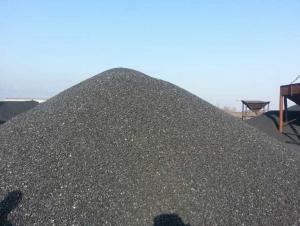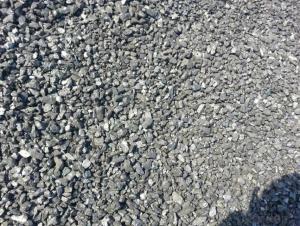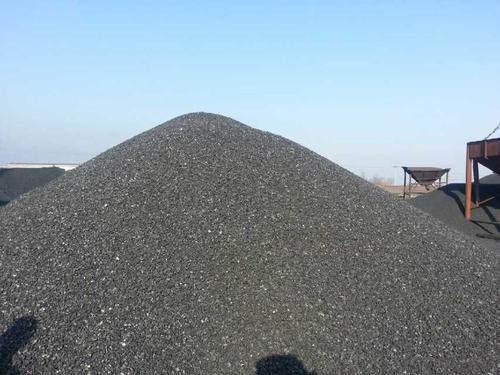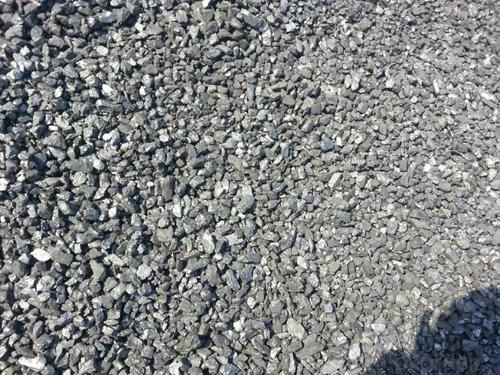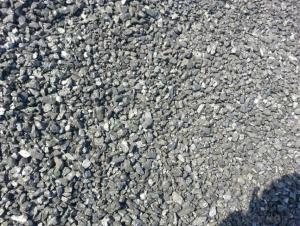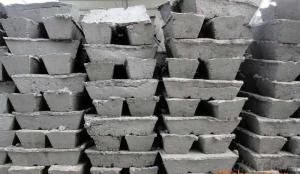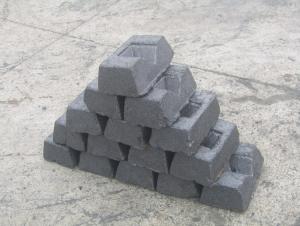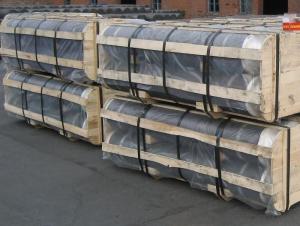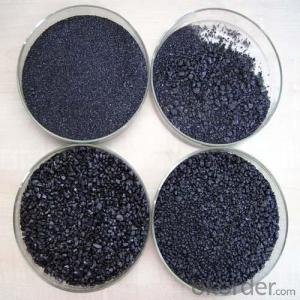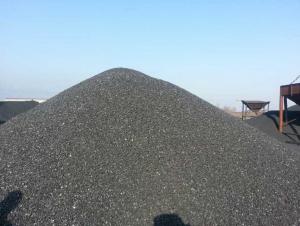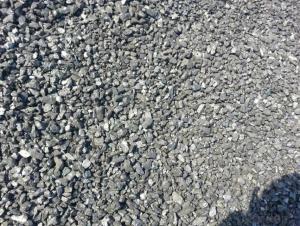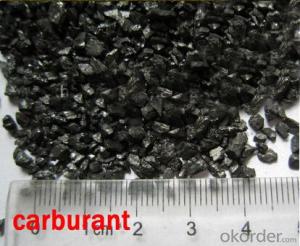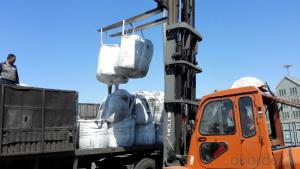Recarburizer FC90% -95% for steel making
- Loading Port:
- Tianjin
- Payment Terms:
- TT OR LC
- Min Order Qty:
- 20 m.t.
- Supply Capability:
- 3000 m.t./month
OKorder Service Pledge
OKorder Financial Service
You Might Also Like
Packaging & Delivery
25kgs/50kgs/1ton per bag or as buyer's request
Specifications
Calcined Anthracite
Fixed carbon: 90%-95%
S: 0.5% max
Size: 0-3. 3-5.3-15 or as request
It used the high quality anthracite as raw materials through high temperature calcined at over 2000 by the DC electric calciner with results in eliminating the moisture and volatile matter from anthracite efficiently, improving the density and the electric conductivity and strengthening the mechanical strength and anti-oxidation. It has good characteristics with low ash, low resistvity, low sulphur, high carbon and high density. It is the best material for high quality carbon products.
Advantage and competitive of caclined anthracite:
1. strong supply capability
2. fast transportation
3. lower and reasonable price for your reference
4.low sulphur, low ash
5.fixed carbon:95% -90%
6..sulphur:lower than 0.3%
General Specification of Calcined Anthracite:
| FC | 95 | 94 | 93 | 92 | 90 |
| ASH | 4 | 5 | 6 | 6.5 | 8.5 |
| V.M. | 1 | 1 | 1 | 1.5 | 1.5 |
| S | 0.3 | 0.3 | 0.3 | 0.35 | 0.35 |
| MOISTURE | 0.5 | 0.5 | 0.5 | 0.5 | 0.5 |
Pictures
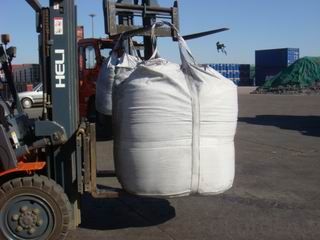
- Q: What is carbon offsetting in aviation?
- The aviation industry utilizes carbon offsetting as a mechanism to counterbalance the carbon emissions it generates. Since airplanes contribute significantly to greenhouse gas emissions, carbon offsetting offers a means for airlines and passengers to acknowledge their carbon footprint and contribute to the battle against climate change. The carbon offsetting process involves calculating the quantity of carbon dioxide and other greenhouse gases released during a flight, and subsequently investing in projects that decrease an equal amount of emissions elsewhere. These projects may encompass initiatives involving renewable energy, forest preservation, or methane capture. The objective is for the emissions reduced or eliminated by these projects to compensate for the emissions produced by the aviation industry. To partake in carbon offsetting, airlines or passengers can acquire carbon offsets, which essentially represent credits equivalent to the reduction or elimination of one metric ton of carbon dioxide or its equivalent. These offsets are generated by certified projects that adhere to stringent standards and undergo independent verification. By investing in carbon offsets, the aviation industry can contribute to global endeavors aimed at reducing greenhouse gas emissions and mitigating the impact of air travel on climate change. It enables airlines and passengers to promptly take action to counteract the environmental repercussions of flying, as the reduction or elimination of emissions from offset projects helps to balance out the emissions generated by air travel. It is crucial to note that carbon offsetting in aviation should not serve as a means to justify or neglect the necessity of long-term solutions to reduce emissions from aircraft. Instead, it should be regarded as a supplementary measure to other strategies, such as investing in more fuel-efficient aircraft, utilizing sustainable aviation fuels, and implementing operational improvements. Nonetheless, carbon offsetting does provide a valuable tool to mitigate emissions in the short term, while the aviation industry endeavors to adopt more sustainable practices.
- Q: How is carbon used in the electronics industry?
- Carbon is used in the electronics industry in various forms, such as carbon nanotubes and graphene, to enhance the performance of electronic devices. These carbon-based materials possess excellent electrical conductivity, high strength, and thermal properties, making them ideal for use in transistors, batteries, capacitors, and other electronic components. Additionally, carbon is used as a crucial element in the manufacturing of printed circuit boards and as a key component in the fabrication of LCD screens and touchscreens.
- Q: How does carbon impact air quality?
- The release of carbon dioxide (CO2) and other carbon-based pollutants into the atmosphere can significantly affect air quality. When fossil fuels like coal, oil, and natural gas are burned, they emit large amounts of carbon dioxide, a greenhouse gas that contributes to climate change. This increase in carbon dioxide levels in the atmosphere causes the Earth's surface to warm, leading to adverse effects on air quality. Moreover, incomplete combustion of fossil fuels and other organic materials can also release carbon-based pollutants like carbon monoxide (CO) and volatile organic compounds (VOCs). These pollutants have detrimental effects on human health and can contribute to the formation of ground-level ozone, which is a major component of smog. Breathing in ozone can cause respiratory problems, lung damage, and worsen existing respiratory conditions such as asthma. Additionally, burning fossil fuels, biomass, and other organic matter releases carbon particles known as black carbon or soot. These particles directly impact air quality by absorbing sunlight and reducing visibility. When inhaled, they can penetrate deep into the lungs, leading to respiratory issues and potential long-term health problems. To improve air quality and mitigate the negative impacts on human health and the environment, it is crucial to reduce carbon emissions. This can be achieved by transitioning to cleaner and more sustainable energy sources, such as renewable energy. Additionally, implementing stricter regulations and emission standards for industries and vehicles can contribute to reducing carbon pollution and improving overall air quality.
- Q: 15CrMo seamless steel tube and carbon plate welding fracture what is the reason?
- That's the problem of too much stress in the welding! 15CrMo material after quenching is very brittle, local high temperature welding, then there is no insulation measures, fast cooling speed caused by the welding part of a slight quenching appear, so the stress concentration caused by cold cracking!It is recommended that the 15CrMo pipe be heated to 150 degrees before welding! Pay attention to heat preservation after welding!If the heat treatment process needs to be welded, the heating rate is 200 degrees /h, rise to 715, holding 1 hours and 15 minutes, the cooling rate is 100 degrees /h, and the air cooling is down to 300 degrees centigrade.
- Q: What are the impacts of carbon emissions on the stability of mountain glaciers?
- Mountain glaciers are significantly affected by carbon emissions, which have significant consequences for their stability. The release of carbon dioxide and other greenhouse gases into the atmosphere contributes to global warming and climate change. This rise in global temperatures directly impacts the health and stability of mountain glaciers. One of the main outcomes of increased carbon emissions is the accelerated melting of mountain glaciers. Warmer temperatures cause glaciers to melt at a faster pace, resulting in a decrease in their size and volume. This not only affects the visual appeal of these natural wonders but also has major implications for water resources and ecosystems. Mountain glaciers serve as natural reservoirs, holding water in the form of ice and gradually releasing it over time. This process helps regulate water flow in rivers and streams, ensuring a consistent water supply for downstream communities, agriculture, and ecosystems. However, as carbon emissions contribute to glacier melting, this natural water storage mechanism is disrupted. The loss of glaciers leads to reduced water availability during dry seasons and can result in water scarcity for communities dependent on glacier meltwater. Moreover, the retreat of mountain glaciers due to carbon emissions has ecological consequences. These glaciers provide critical habitats for various plant and animal species. The loss of glacier ice and associated ecosystems can have a ripple effect on the entire ecosystem, resulting in the decline or even extinction of species reliant on glacier-fed environments. The impacts of carbon emissions on mountain glaciers also extend beyond local communities and ecosystems. Glacial meltwater plays a significant role in the overall water supply in many regions globally. As glaciers shrink and vanish, the availability of water resources becomes uncertain, particularly in areas heavily reliant on glacier meltwater. This can potentially lead to conflicts over water resources and worsen existing tensions. In conclusion, the stability of mountain glaciers is severely affected by carbon emissions. The accelerated melting of glaciers disrupts water availability, threatens ecosystems, and presents challenges for water resource management. It is crucial to reduce carbon emissions to mitigate these impacts and preserve the integrity and functionality of mountain glaciers.
- Q: What are the impacts of carbon emissions on biodiversity?
- Biodiversity is significantly affected by carbon emissions, which have various consequences. One of the primary outcomes is climate change, which results from the release of greenhouse gases, including carbon dioxide, into the atmosphere. As the Earth's temperature increases, it disrupts the delicate balance of ecosystems, causing the loss of biodiversity. Habitat loss is a major effect of climate change on biodiversity. Many species are adapted to specific environmental conditions, and as these conditions change, their habitats become unsuitable. This can lead to the extinction of species that cannot adapt or migrate to new areas. For instance, coral reefs are highly sensitive to temperature changes, and with the ocean warming due to carbon emissions, numerous coral species are at risk of bleaching and dying off. Carbon emissions also disrupt ecological interactions, which are crucial for the survival of many species. Numerous species rely on specific relationships with other species, such as pollination or predation. Climate change can alter the timing of these interactions, potentially causing mismatches between species. For example, if flowering plants bloom earlier in the year due to warmer temperatures, but their pollinators are not yet active, it can result in reduced pollination and reproductive success. Furthermore, carbon emissions contribute to ocean acidification, which occurs when seawater absorbs carbon dioxide, leading to a decrease in pH. This acidification negatively affects marine organisms, especially those with calcium carbonate shells or skeletons, like corals, mollusks, and some plankton. The increased acidity makes it challenging for these organisms to build and maintain their protective structures, potentially causing population declines and disruptions in ecosystems. In general, the impacts of carbon emissions on biodiversity are extensive and profound. They not only threaten individual species but also disturb entire ecosystems and their functioning. To mitigate these effects, it is essential to reduce carbon emissions and transition to cleaner and more sustainable energy sources. Additionally, conserving and restoring habitats, implementing effective conservation strategies, and promoting sustainable land and water management practices can help protect and restore biodiversity in the face of climate change.
- Q: Carbon content of fly ash and fly ash roasted vector what is the relationship?
- The higher the carbon content, the greater the adsorption, the lower the activity index.In the process of coal ash processing, there are still many places to use the fly ash mill. The carbon content of fly ash is related to the boiler property and combustion technology. China's newly built modern power plant, the content of fly ash can be reduced to l% ~ 2%, and some power plants may also be as high as 20%.
- Q: What is carbon dioxide?
- Carbon dioxide (CO2) is a colorless and odorless gas that consists of carbon and oxygen atoms. It is formed through the combustion of fossil fuels, as well as the natural processes of respiration and volcanic activity. Carbon dioxide plays a crucial role in the Earth's atmosphere as a greenhouse gas, trapping heat and contributing to the planet's overall temperature. While it occurs naturally, human activities such as burning of fossil fuels and deforestation have significantly increased its concentration in the atmosphere, leading to global warming and climate change. Carbon dioxide is also a byproduct of various industrial processes, such as cement production and power generation. Efforts to reduce carbon dioxide emissions are essential to mitigate the effects of climate change and maintain a sustainable environment.
- Q: How are carbon-based polymers synthesized?
- Carbon-based polymers are synthesized through a process called polymerization, which involves the bonding of monomers (smaller units) together to form long chains or networks. This can be achieved through various methods such as addition polymerization, condensation polymerization, or ring-opening polymerization, depending on the type of polymer desired.
- Q: How does carbon dioxide affect the Earth's atmosphere?
- Carbon dioxide (CO2) affects the Earth's atmosphere in several ways. First and foremost, it is a greenhouse gas, meaning it traps heat from the sun and prevents it from escaping back into space. This process, known as the greenhouse effect, plays a vital role in maintaining Earth's temperature range and making our planet habitable. However, excessive amounts of CO2 in the atmosphere can intensify the greenhouse effect, leading to global warming and climate change. Human activities, such as burning fossil fuels for energy and deforestation, have significantly increased the concentration of CO2 in the atmosphere since the industrial revolution. The increased levels of CO2 contribute to the rising global temperatures, melting polar ice caps, and changing weather patterns. These changes have severe consequences, including more frequent and intense heatwaves, droughts, floods, and storms. Additionally, CO2 absorption by the oceans leads to ocean acidification, which harms marine life and coral reefs. Furthermore, the increase in CO2 levels affects ecosystems and biodiversity. Plants use CO2 during photosynthesis, but excessive amounts can disrupt their growth and alter the balance of ecosystems. This disruption can have cascading effects on other organisms that rely on the affected plant species for food or shelter. Overall, the excess of carbon dioxide in the Earth's atmosphere is contributing to significant environmental changes and poses a threat to the stability of our planet. It is crucial to reduce CO2 emissions, promote sustainable practices, and develop alternative energy sources to mitigate the impacts of climate change and preserve the health of our atmosphere.
Send your message to us
Recarburizer FC90% -95% for steel making
- Loading Port:
- Tianjin
- Payment Terms:
- TT OR LC
- Min Order Qty:
- 20 m.t.
- Supply Capability:
- 3000 m.t./month
OKorder Service Pledge
OKorder Financial Service
Similar products
Hot products
Hot Searches
